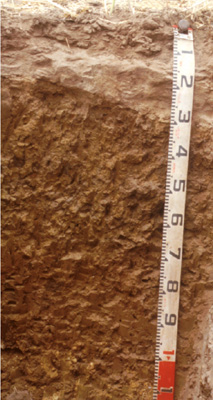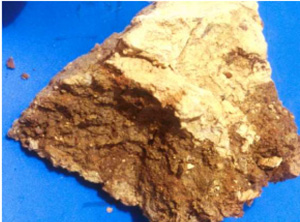SFS22
|
| SFS22 |  Vertic (& Calcic), Mottled-Mesonatric, SODOSOL | |
| Rocklea (west of Shelford) | |||
| Undulating plain | |||
| Neogene sediments (Moorabool Viaduct) | |||
| Simple slope | |||
| 1.5% | |||
Australian Soil Classification | South Vertic (& Calcic), Mottled-Mesonatric, SODOSOL | |||
Horizon | Depth (cm) | Description | ||
Ap | 0–10 | Dark brown (10YR3/3/ moist) to light yellowish brown (10YR6/4 dry); loamy sand; apedal structure loose with some weak fragments; pH 6; abrupt boundary to: | ||
A2(e) | 10–20/35 | Dark yellowish brown (10YR4/4 moist) to pale brown (10YR6/3 dry) or light yellowish brown (10YR6/4 moist) to very pale brown (10YR7/3 dry); variable thickness and more bleached where closer to A2/B21 boundary; few coarse buckshot/ferruginous gravel in thicker zones of A2; sandy loam; apedal structure, firm (dry); sharp, smooth and wavy boundary to: | ||
B21t | 20/35–65 | Brown (10YR4/3) ped faces with yellowish brown (10YR5/6) matrix with common (10-20%) red (10R4/6) mottles; medium clay; coarse (40-80 mm) prismatic (some peds tending to have domed tops, i.e. columnar) parting to coarse (20 mm) angular blocky, polyhedral and even lenticular peds; pH 8; gradual or diffuse boundary to: | ||
B22t | 65-95 | Dark yellowish brown (10YR4/6) matrix and strong brown (5YR4/6) ped surfaces; medium clay; angular blocky and lenticular peds (30–60 mm); many vertic features. pH 8.5; clear boundary to: | ||
B23k or C/B | 95-120+ | Strong brown (7.5YR5/8) matrix with yellowish red (5YR4/6) ped surfaces/infill; light clay; soft yellow (10YR7/6) calcium carbonate, visible effervescence with dilute acid. | ||
| Management considerations | ||||
| The texture contrast and the sodic (ESP is around 25%) subsoil restricts drainage and the soils readily become waterlogged in winter. The sandy topsoil is very susceptible to soil structure decline; the weak aggregation is readily destroyed by cultivation and the soils are prone to compaction. Bare soil is vulnerable to structural breakdown by rain (slaking and sealing) and to erosion by water. In dry conditions these soils are known to be vulnerable to wind erosion. Plough pans are common in these soils. Disruption of pans by tillage is short lived unless controlled traffic is deployed in cropping situations. Raised beds have been used with some degree of success in these soils but the unstable topsoils do not lend themselves well to bed survival. Other parts of the paddock were reported as having a high gravel or buckshot content though little was found in this pit. See also SFS19 for related soil. Principal difference between this and SFS19 is the presence of calcareous material at 1 metre and the higher sodicity (SFS19 is only marginally sodic). | ||||
Analytical data
Site SFS22 | Sample depth | pH | EC | NaCl | Ex Ca | Ex Mg | Ex K | Ex Na | Ex Al | Ex acidity | FC (-10kPa) | PWP (-150kPa) | KS | FS | Z | C | |
Horizon | cm | H2O | CaCl2 | dS/m | % | cmolc/kg | cmolc/kg | cmolc/kg | cmolc/kg | mg/kg | cmolc/kg | % | % | % | % | % | % |
Ap | 0-15 | 6.0 | 5.6 | 0.21 | N/R | 6.1 | 1.2 | 0.50 | 0.41 | <10 | 6.3 | 14.8 | 8.7 | 14.4 | 62.7 | 8.0 | 7.5 |
A2 | 15-30 | 5.7 | 5.3 | 0.14 | N/R | 1.1 | 0.46 | <0.05 | 0.19 | <10 | 1.7 | 10.8 | 2.0 | 16.4 | 68.4 | 8.5 | 5.0 |
B21 | 30-50 | 7.2 | 6.4 | 0.31 | 0.03 | 4.9 | 7.8 | 0.4 | 4.2 | N/R | N/R | 35.5 | 23.4 | 5.1 | 23.1 | 4.0 | 65.0 |
B22 | 70-90 | 8.7 | 7.9 | 0.54 | 0.06 | 4.6 | 10.0 | 0.4 | 5.7 | N/R | N/R | 39.1 | 20.1 | 6.2 | 35.3 | 4.5 | 51.0 |
B23 | 100-120 | 9.3 | 8.6 | 0.69 | 0.07 | 4.7 | 9.9 | 0.4 | 5.6 | N/R | N/R | N/R | N/R | N/R | N/R | N/R | N/R |



